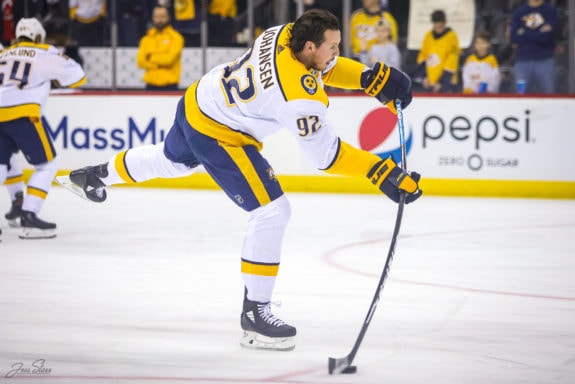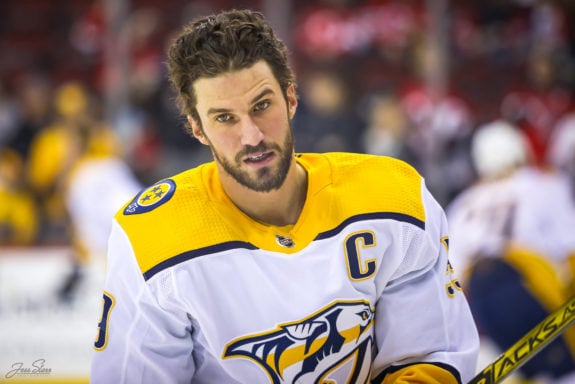A face off loss. A fortuitous deflection in front. The final moments of Game 6 against the Carolina Hurricanes in the 2021 Stanley Cup First Round is something fans of the Nashville Predators won’t soon forget.
The Predators seemingly had all the pieces together. They had a top six that could score and compete, a bottom six capable of shutting down the neutral zone and playing a physical game, and a defensive core capable of clogging up high-danger areas. Goaltender Juuse Saros wasn’t half bad either, playing outstanding in Games 3 and 4, where he was peppered with 56 and 61 shots, respectively. The Predators won both those games, in overtime, which tied the series at two.
It was clear, however, that the Predators’ firepower up front, as good as it was, was no match for the Hurricanes. With another year of disappointment, general manager David Poile was left with decisions to make. Instead of a shakeup, the team remained relatively the same; only minor tweaks and the departure of forward Viktor Arvidsson stand out. The message was clear that Poile believed in this team, and it was only a matter of the team believing in themselves.
Predators Players Bouncing Back
Nashville has its fair share of high-end players who are capable of putting up big numbers. Look no further than names like Filip Forsberg, Matt Duchene and Ryan Johansen, three players that are paid handsomely for their abilities and counted on to put the team on the map. While Forsberg gave a noble performance with 32 points in 39 games, both Johansen and Duchene struggled.

In the 2019-20 season, Johansen finished off the fourth year of his eight-year, $8 million AAV contract with a modest performance, scoring 36 points in 68 games. Despite a first-round sweep in the playoffs that season, he managed one goal and four assists in those four games. Not much to complain about in terms of his play, but you would hope that with the amount he was making, he’d be contributing more. The following year was more-or-less the same, with 22 points in 48 games and some inconsistencies with his play without the puck. Some fans started becoming impatient with his inability to engage in every game he appeared in, and rightfully so. Your top performers should be the ones who are paid the most, and for Johansen, this was becoming a concern.
Related: Predators’ Undrafted Jeannot Making His Case for the Calder
Fast forward one year and it’s the complete opposite. Johansen has become one of the Predators’ best point producers. He’s engaged in every battle for the puck, and he looks hungry. Having already surpassed last season’s point totals, Johansen is poised to play his best season statistically in the last three years, and possibly as a member of the Predators. Head coach John Hynes has continued to trust the star forward in big moments when the team needs a goal, and he’s stepped up to the plate.
Last season, Duchene had a season he’d probably like to forget. For fans, they’d be on board with this sentiment.

After a disappointing second-round exit in the 2019 Stanley Cup Playoffs as a member of the Columbus Blue Jackets, Duchene chose to pursue his career in the capital city of country music. Nearly identical to Johansen’s contract, just one year less, Duchene joined the team as one of the highest paid forwards on the Predators’ payroll. His name was well known around the league, and along with Johansen, he gave the team a very dynamic two-line combination that could deliver on a nightly basis. In the 2019-20 season, his first year with the club, Duchene gave the team a taste of his potential, posting 42 points in 66 games. Unfortunately, there would be no aftertaste the following season, as he stepped off a cliff and put in the worst statistical season of his career.
For management and fans, this was a major concern. The disastrous season came just two years into his expensive contract, and fans had begun to doubt Duchene’s capabilities of bouncing back. He gave the team and their fans little to believe in with his uninspired play and lack of compete level. That is until he turned things around for the 2021-22 season. Duchene has remained at around a point-per-game pace thus far, averaging 19 minutes of ice time per game, and he’s remained clutch in games when the team needed him the most.
Duchene and Johansen, much like the Predators team at the conclusion of the 2021 postseason run, had hit rock bottom. It was the belief in each other and the facing of adversity that has led both star players and the team itself into one of the most successful starts to a season in franchise history.
Predators’ Contributions From the Depths
When you can’t rely on your star players every night or every shift, it’s nice to have some depth in your bottom-six and bottom pairings. On Stanley Cup-winning teams, this has become such an important luxury to have. When the Tampa Bay Lightning won their second consecutive Cup, it was Ross Colton who they leaned on to score the game-winning goal in Game 6. At the time, he was making under $1 million and playing on the team’s bottom six. The year before that? Blake Coleman scored the insurance goal in Game 6 against the Dallas Stars, and both Cedric Paquette and Patrick Maroon notched assists. All three players combined made less than Brayden Point, the player to score the game’s first goal.
Taking a look at the bottom end of the Predators’ roster, we’re seeing promising qualities. The line of Luke Kunin, Tanner Jeannot, and Colton Sissons has been monumental in the team’s current run. With the injuries that have occurred, paired with players entering COVID-19 protocol, Hynes has shuffled the deck and given more responsibility to Jeannot and Kunin, with the former getting time on the second line and the latter seeing power-play opportunities. Players like Yakov Trenin and Michael McCarron have stepped up and not looked out of place. Philip Tomasino has played exceptionally well, and Nick Cousins hasn’t looked out of place when called upon to play on the top-six and first power-play wave.

On the back end, while Roman Josi has been in proper Norris form, the team has also thankfully received better services from Mattias Ekholm, who had a shaky start to his season. Nearing the end of 2021 and into the new year, Ekholm has looked more poised and confident, qualities we have seen from the 31-year-old in past seasons. While the defensive side of his game hasn’t been bad, his physicality went unnoticeable until recently, so it’s a welcoming presence to have in the Predators’ top-four as the team makes a push for the top spot in the conference (Ekholm signed a 4-year, $25 million extension, which kicks in next season).
Filling in the first two pairings, along with Josi and Ekholm, have been the likes of Dante Fabbro, Alexandre Carrier, and Matt Benning, all of whom have seen opportunities on all three pairings. Along with veteran Matt Borowiecki, these three have been integral pieces in what makes the Predators’ defensive core what it is today. Limiting high-danger scoring chances, clogging up the neutral zone, throwing big hits, and playing a big part in starting rushes up the ice, they can really do it all. When you consider they have the likes of Ben Harpur and Phillipe Myers in the wings to step in should anything happen, and the Predators’ blue line looks competitive and one of the deepest we’ve seen in years.
It All Starts Between the Pipes
It’s easy to forget just how good Saros has been this season when you have a Norris candidate, Calder candidate, and Forsberg, Duchene, and Johansen lighting it up this season. But the 26-year-old netminder has been phenomenal in 2021-22. The Predators’ current run of 7-2-1 in their last ten games is thanks in large part to the quality of play from Saros. Just last week, he received the second star of the week by NHL.com voting, and the NHLPA named him player of the week.
Saros’ most recent run has not only aided his team to reach the top spot in the Western Conference but also earned him Vezina discussions. If you look at the way he’s played, and how he measures up statistically, it’s not such a stretch anymore. He currently leads the league in games played (30), wins (20), shots against (937), and saves (870). His save percentage (SV%) of .928 currently ranks him in fifth place, not too far behind the four goaltenders ahead of him. At even-strength, no goaltender faces more shots or made more saves than him, and the same goes for when the team is killing off penalties. If it weren’t for his strong play, the Predators would be doing much worse than ninth-best in the league in penalty kill.
In the 30 games that Saros has started this season, he’s registered a .900 SV% in 23 of them, tying him with Andrei Vasilevskiy for first place in that statistic. Percentage-wise, this means in 76.7 percent of the games he’s played, he’s registered at least a .900 SV% or higher. Also, of the 30 games he’s started, Saros has only been pulled once. Considering only Tristan Jarry, Jordan Binnington, and Jacob Markstrom haven’t been pulled all season among goaltenders who have appeared in at least 20 games, this is quite promising as the team goes deeper into the season.
What Are the Predators’ Odds?
While a rough start to the season left some in doubt, it’s safe to see the Predators’ start to the new year, and rise in the Western Conference, has put an end to the detractors. Sitting in first place in the West, they are also fourth-best in terms of points percentage, just behind the Colorado Avalanche, St. Louis Blues, and Minnesota WIld, all who have games in hand over Nashville. League-wide, this puts the Predators just outside the top ten teams. With the exception of Tampa Bay, all teams ahead of the Predators have games in hand over Nashville, so pending results could affect Nashville’s placement significantly.

The Predators currently have a 96.9 percent chance of making the playoffs, meaning barring any significant injury to top players or Saros, they’ll make it to the dance. They have a 58.8 percent chance of making it to the second round, behind just the Avalanche (60.7 percent) and Hurricanes (59.8 percent). Making it to the third round puts them at 32.4 percent, while making the Final is currently at 18 percent. The big question is what are their chances of winning it all and hoisting the Stanley Cup for the first time in franchise history? A whopping 9.6 percent, which may seem low at first glance, but only the Lightning (10.6 percent) and Avalanche (10.1 percent) are ahead of them.
If ever there was a year where the Predators hold their best chance to reach the pinnacle and see their names carved into the Stanley Cup, this would be it. Top to bottom, the team has scoring, grit, defensive awareness, and one of the league’s best goaltenders currently in the game. With Forsberg’s future with the team in question, and decisions to be made following the conclusion of this season, the window may be starting to come down. Not fully closing, but making the air a little more difficult to circulate. It has to be now, or it may not be for a long while.